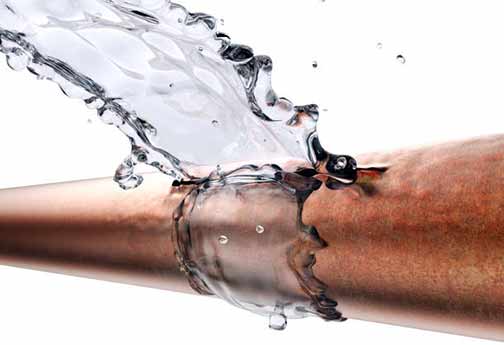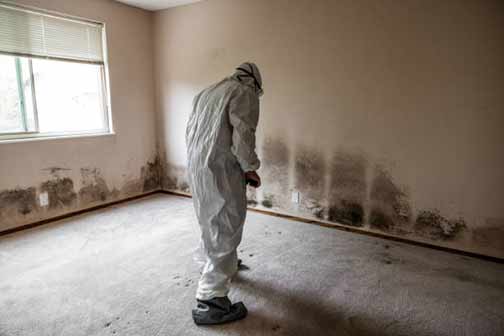
A burst pipe can cause significant water damage to your property, and one of the most concerning consequences is the growth of mold and mildew. Mold and mildew thrive in damp, humid environments, making the aftermath of a burst pipe an ideal breeding ground. Understanding the risks associated with mold and mildew is crucial for taking the necessary steps to mitigate their impact on your property and health.
Mold and mildew can cause structural damage to your home, as they feed on organic materials like wood, drywall, and insulation. This can weaken the integrity of your walls, ceilings, and floors, leading to costly repairs. Additionally, mold spores can spread rapidly through the air, contaminating other areas of your home and making the problem more difficult to contain.
The health risks associated with mold and mildew exposure are also significant. Inhaling mold spores can cause respiratory issues, allergic reactions, and other health problems, particularly for individuals with preexisting conditions such as asthma or weakened immune systems. Prolonged exposure to mold can lead to chronic health issues, making it essential to address the problem promptly and effectively.
Immediate Actions to Take Following a Burst Pipe
When a burst pipe occurs, it’s crucial to act quickly to minimize water damage and prevent mold and mildew growth. Here are some immediate actions to take:
- Shut off the water supply: Locate the main water valve and turn it off to stop the flow of water. This will help prevent further flooding and reduce the amount of water damage.
- Remove standing water: Use a wet/dry vacuum, mop, or towels to remove as much standing water as possible. The longer water sits, the greater the risk of mold and mildew growth.
- Dry the affected area: Open windows and doors to promote air circulation and use fans and dehumidifiers to help dry out the area. The goal is to reduce humidity and moisture levels as quickly as possible.
- Remove damaged materials: If any materials, such as carpets, furniture, or drywall, have been soaked by the water, remove them from the affected area. These materials can retain moisture and contribute to mold growth.
- Clean and disinfect: Use a mixture of water and mild detergent to clean surfaces that have come into contact with water. This will help remove any dirt and debris that could harbor mold spores. Follow up with a disinfectant to kill any remaining mold spores.
Effective Methods for Mold and Mildew Removal
Once you’ve taken immediate actions to mitigate water damage, it’s time to focus on removing any existing mold and mildew. Here are some effective methods for mold and mildew removal:
- Scrub with a brush: Use a stiff-bristled brush and a mixture of water and detergent to scrub mold and mildew from surfaces. Be sure to wear protective gear, such as gloves and a mask, to avoid inhaling mold spores.
- Use a commercial mold remover: There are many commercial mold removal products available that are specifically designed to kill mold and mildew. Follow the manufacturer’s instructions for best results.
- Apply white vinegar: White vinegar is a natural mold killer. Spray undiluted white vinegar onto the affected area and let it sit for an hour before wiping it away with a clean cloth.
- Use hydrogen peroxide: Hydrogen peroxide is another effective mold killer. Spray a 3% hydrogen peroxide solution onto the moldy area and let it sit for 10 minutes before scrubbing with a brush and wiping clean.
- Baking soda: Baking soda can be used to remove mold and mildew from surfaces. Mix one-quarter tablespoon of baking soda with water to form a paste, apply it to the affected area, and scrub with a brush. Rinse with water and wipe clean.
Professional Mold Inspection and Testing
If you suspect that mold and mildew have spread beyond what you can see, it may be necessary to hire a professional mold inspector. A professional inspection can help identify hidden mold and determine the extent of the infestation. Mold inspectors use specialized equipment, such as moisture meters and thermal imaging cameras, to detect mold growth in areas that are not easily visible.
Professional mold testing can also provide valuable information about the types of mold present in your home and the potential health risks they pose. Air and surface samples are collected and analyzed in a laboratory to determine the concentration and species of mold spores. This information can help guide the remediation process and ensure that all mold is effectively removed.

Preventive Measures to Avoid Future Mold and Mildew Growth
Preventing mold and mildew growth is key to maintaining a healthy living environment. Here are some preventive measures you can take:
- Control humidity levels: Use dehumidifiers and air conditioners to keep indoor humidity levels below 60%. This will make it more difficult for mold and mildew to thrive.
- Fix leaks promptly: Address any leaks in your plumbing, roof, or windows as soon as they are discovered. Even small leaks can lead to significant mold growth if left untreated.
- Improve ventilation: Ensure that your home is well-ventilated, especially in areas prone to moisture, such as bathrooms, kitchens, and basements. Use exhaust fans and open windows to promote air circulation.
- Use mold-resistant products: When renovating or building, consider using mold-resistant drywall, paint, and insulation. These products are designed to inhibit mold growth and can provide an extra layer of protection.
- Regularly clean and maintain: Regularly clean and maintain your home to prevent mold and mildew buildup. Pay special attention to areas that are prone to moisture and use mold-killing cleaning products as needed.
Choosing the Right Professionals for Mold and Mildew Removal
When it comes to mold and mildew removal, choosing the right professionals is crucial for ensuring a thorough and effective remediation process. Here are some tips for selecting the right mold removal experts:
- Look for certification: Choose a mold remediation company that is certified by a reputable organization, such as the Institute of Inspection, Cleaning, and Restoration Certification (IICRC). Certification indicates that the company has the necessary training and expertise to handle mold removal safely and effectively.
- Check references and reviews: Ask for references from past clients and read online reviews to get an idea of the company’s reputation and the quality of their work.
- Get multiple quotes: Obtain quotes from several mold remediation companies to compare prices and services. Be wary of companies that offer significantly lower prices than others, as this may indicate subpar work or hidden fees.
- Ask about their process: Inquire about the company’s mold removal process, including the methods and products they use. A reputable company should be transparent about their procedures and willing to answer any questions you have.
- Verify insurance and guarantees: Ensure that the mold remediation company has adequate insurance coverage to protect against any potential damage or liability. Additionally, ask if they offer any guarantees or warranties on their work.
The Importance of Proper Ventilation and Dehumidification
Proper ventilation and dehumidification are essential for preventing mold and mildew growth in your home. By controlling moisture levels and promoting air circulation, you can create an environment that is less conducive to mold development.
Ventilation helps to remove excess moisture from the air and prevent condensation from forming on surfaces. This is particularly important in high-humidity areas, such as bathrooms, kitchens, and basements. Installing exhaust fans, opening windows, and using ceiling fans can all help improve ventilation in your home.
Dehumidification is another key component of mold prevention. Dehumidifiers work by removing excess moisture from the air, reducing humidity levels and making it more difficult for mold and mildew to grow. Place dehumidifiers in areas prone to moisture, such as basements and laundry rooms, and monitor humidity levels regularly to ensure they remain below 60%.
Legal and Insurance Considerations in Mold and Mildew Cases
Dealing with mold and mildew can have legal and insurance implications. Understanding your rights and responsibilities can help you navigate these issues more effectively.
Homeowners’ insurance policies typically cover water damage resulting from sudden and accidental events, such as a burst pipe emergency. However, coverage for mold remediation may be limited or excluded altogether. Review your policy carefully to understand what is covered and consider purchasing additional mold coverage if necessary.
If you rent your property, your landlord may be responsible for addressing mold and mildew issues. Check your lease agreement and local laws to determine your rights as a tenant. If your landlord fails to take appropriate action, you may need to seek legal assistance to resolve the issue.
In some cases, mold and mildew can lead to disputes between property owners, tenants, and insurance companies. Keeping detailed records of the damage, remediation efforts, and communications with involved parties can help protect your interests in the event of a legal dispute.
Long-Term Health Implications of Mold and Mildew Exposure
Exposure to mold and mildew can have serious long-term health implications, particularly for individuals with preexisting conditions or weakened immune systems. Understanding these risks can help you take appropriate measures to protect your health and the health of your loved ones.
Common health issues associated with mold exposure include respiratory problems, such as asthma and bronchitis, as well as allergic reactions, such as sneezing, coughing, and skin rashes. In some cases, mold exposure can lead to more severe health problems, such as chronic sinus infections, neurological issues, and immune system suppression.
Prolonged exposure to mold can also exacerbate existing health conditions, making it more difficult to manage symptoms and maintain overall well-being. Children, the elderly, and individuals with compromised immune systems are particularly vulnerable to the effects of mold exposure.
To minimize the health risks associated with mold and mildew, it’s essential to address any mold issues promptly and take preventive measures to avoid future growth. Regularly monitor your home for signs of mold and mildew, and seek professional assistance if you suspect a mold problem.
Conclusion: Ensuring a Safe and Healthy Living Environment
Dealing with the aftermath of a burst pipe can be challenging, but taking prompt and effective action can help minimize the risks associated with mold and mildew growth. By understanding the dangers of mold and mildew, taking immediate steps to address water damage, and implementing preventive measures, you can protect your property and health.
Choosing the right professionals for mold removal, ensuring proper ventilation and dehumidification, and being aware of legal and insurance considerations can further enhance your efforts to maintain a safe and healthy living environment. By staying vigilant and proactive, you can reduce the likelihood of mold and mildew problems and enjoy peace of mind in your home.

